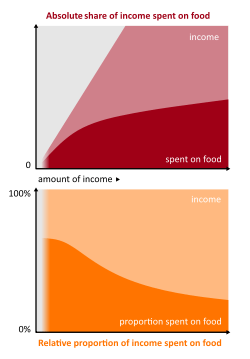Engel's law
Engel's law is an observation in economics stating that, as income rises, the proportion of income spent on food falls―even if absolute expenditure on food rises. In other words, the income elasticity of demand of food is between 0 and 1.

The law was named after the statistician Ernst Engel (1821–1896).
Engel's law does not imply that food spending remains unchanged as income increases; instead, it suggests that consumers increase their expenditures for food products in percentage terms less than their increases in income.[1][2]
One application of the statistic is treating it as a reflection of the living standard of a country; as that proportion―or "Engel coefficient"―increases, the country is by nature poorer. Conversely, a low Engel coefficient indicates a higher standard of living.
The interaction between Engel's law, technological progress, and the process of structural change is crucial for explaining long-term economic growth as suggested by Leon,[3] and Pasinetti.[4]
See also
References
- Engel, Ernst (1857). "Die Productions- und Consumtionsverhältnisse des Königreichs Sachsen". Zeitschrift des statistischen Bureaus des Königlich Sächsischen Ministerium des Inneren. 8–9: 28–29.
... je aermer eine Familie ist, einen desto groesseren Antheil von der Gesamtausgabe muss zur Beschaffung der Nahrung aufgewendet werden ...
- See Timmer, C. P.; Falcon, W. P.; Pearson, S. R. (1983). Food policy Analysis. Baltimore: Johns Hopkins University Press. p. 43. ISBN 0-8018-3072-9.
- Leon, P. (1967). Structural Change and Growth in Capitalism. Baltimore: Johns Hopkins.
- Pasinetti, L (1981). Structural Change and Economic Growth: a Theoretical essay on the dynamics of the wealth of nations. Cambridge University Press. ISBN 0-521-23607-X.